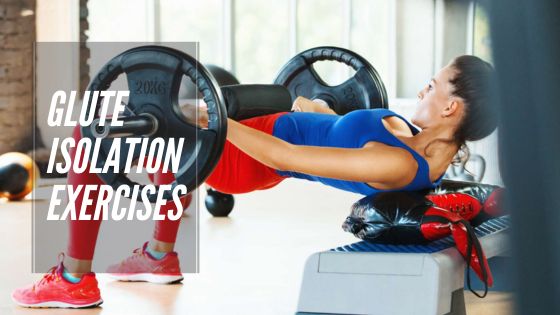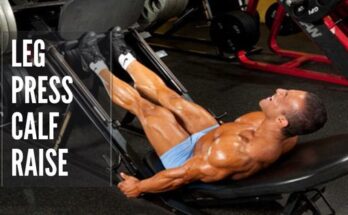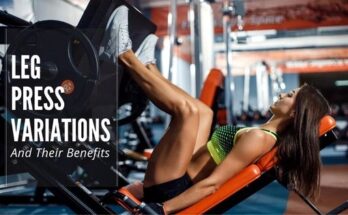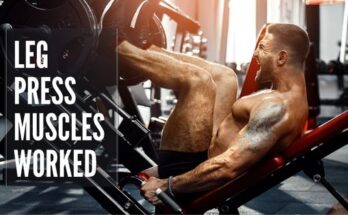Glute Isolation Exercises: Overview
Guys want strong butts and girls want that apricot booty, but people, especially males, often ignore training their glutes. Or else, doesn’t train them as intensely as quads and hamstrings. In fact, the glutes are maybe the most leftover muscle group.
If you want to strengthen your butts, you have to add some isolation exercises to train your glutes directly. Strong glutes help you in giving a firm backside, strengthen your overall posterior chain, and improve your squat and deadlift performance.
In this article, you’ll learn about glutes, their anatomy, the benefits of training them, why you need to isolate them, and exercises to train your glutes directly.
The best glute isolation exercises are:
- Hip thrusts
- Smith machine hip thrusts
- Glute bridges
- Single-leg glute bridges
- Donkey kicks
- Banded fire hydrants
- Cable glute kickbacks
- Banded glute kickbacks
- Lateral band walks
- Side-lying hip abduction
But before looking at the exercises, first, understand the anatomy of the glutes and why you need to strengthen your glutes.
The Anatomy of Glutes
The glutes or butts are a big muscle group that can be divided into 3 different muscles – gluteus maximus, gluteus medius, and gluteus minimus.

1. Gluteus Maximus
The gluteus maximus is the largest muscle of your butt. In fact, this is the largest muscle of the human body. You may think that the back is the largest but the back is a muscle group that consists of various different muscles.
This muscle gives you that round look to your butts. It starts from your pelvic bone and runs down to the femur (thigh bone).
Gluteus Maximus helps in various functions including hip extension, external rotation, and hip adduction/abduction, and provides stability to stay in an upright position.
2. Gluteus Medius
The gluteus medius is smaller than the gluteus maximus. This muscle is located at the upper outer side of the butts and most part of it is covered by the gluteus maximus. This muscle is very thick and starts from the hip bone and travels down to the hip.
The main function of this muscle is to help in the internal rotation of the legs. Apart from that, the gluteus maximus provides control and stability while doing activities like walking and running.
3. Gluteus Minimus
This is the smallest glute muscle that lies under the other two gluteal muscles. The function of the gluteus minimus is similar to that of the gluteus medius and it mainly helps in the internal rotation of the thighs.
10 Best Glute Isolation Exercises
Here are the 10 best glute isolation exercises to train your glutes effectively.
1. Hip Thrusts

Key features:
- One of the best exercises
- Hits all the gluteal muscles
- Can be done with barbell, dumbbell, or plates
Hip thrusts are one of the most famous and most effective exercises to train the glutes. I recommend this exercise to all my clients.
Though you may feel awkward while performing this exercise when it comes to results, you can not miss hip thrusts.
No machines or fancy equipment are required to do this exercise. You just need a bench or a box and some weights. You can use a dumbbell, or barbell, or put some plates on your lap as the weight to increase resistance.
Hip thrusts are one of the best glutes exercises because they include all the 3 muscles of the glutes. Although hamstrings and quads are slightly involved in this the glutes play a major role.
2. Smith Machine Hip Thrusts
Key features:
- No need for a partner to put on weights
- Hits all the gluteal muscles
- Easy to do progressive overloading
This exercise is just another version of the hip thrust. The movement pattern is the same but you are doing it with the help of a Smith machine.
The main advantage of Smith machine hip thrust is that it saves you from the chores of putting a dumbbell or barbell on your lap. So if you have a Smith machine in your gym, switch to this variation.
3. Glute Bridge
Key features
- No equipment needed
- Beginner’s friendly
This exercise is similar to hip thrusts. The only difference is that instead of a bench, you lie down on the floor with your back touching the floor.
It is a beginner-friendly exercise as there is no extra weight to increase the resistance. Also, you can do this exercise if you don’t have access to a bench or box.
4. Single-leg Glute Bridges
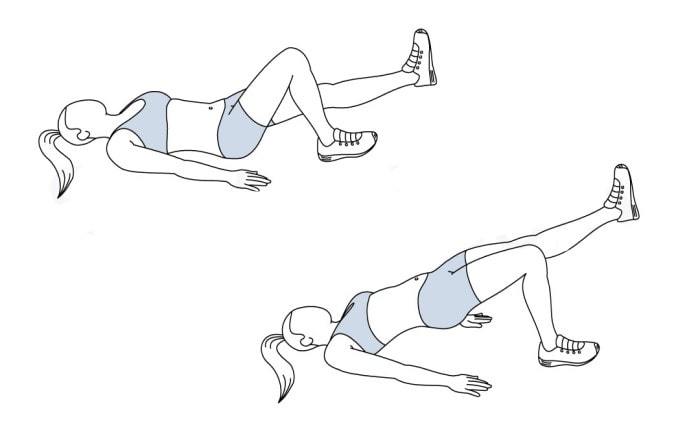
Key features
- No equipment needed
- Good for reducing muscle imbalance
- Beginner’s friendly
This is another glute isolation exercise that you can do without any equipment. As the name suggests, you have to do this exercise with one leg at a time. Apart from that, the movement pattern is the same as the glute bridges.
The major advantage of this exercise is that it helps you in reducing muscle imbalance. You can strengthen your weaker glute by giving extra sets or reps to that leg.
Apart from the glutes, glute bridges also involve core muscles, hip flexors, and knee extensors.
5. Donkey Kicks
This is a different variation to train glutes in which your back does not come in contact with the ground. You lie down on your knees and kick your leg backward (one leg at a time).
Key features:
- No equipment needed
- Good for reducing muscle imbalance
- Beginner’s friendly
It’s an effective exercise if you don’t have any equipment or access to the gym. You can do it at your home too. This exercise also helps in reducing muscle imbalance as you are doing one leg at a time.
As you are not using any external resistance, so you need to do this exercise for higher reps (about 20-30 reps per set).
6. Cable Glute Kickbacks
Key features:
- Intermediate level exercise
- Good for reducing muscle imbalance
- Easy to do progressive overloading
This is just another variation of donkey kicks. The movement pattern is the same but with some extra resistance. You can switch to this exercise if you need more resistance and have access to a cable pulley machine.
This exercise is slightly more difficult than donkey kickbacks. Hence, start with normal kickbacks as a beginner and then move on to this cable variation after gaining some experience.
7. Banded Glute Kickbacks
Key features:
- Don’t need any machine
- Good for reducing muscle imbalance
Here’s the alternative to cable glute kickbacks. If you don’t have access to a cable pulley machine then you can use a resistance band to increase the resistance.
8. Banded Fire Hydrants
Key features:
- No need for machines
- Good for targeting Gluteus Medius
- One leg at a time
The movement of this exercise is different from other exercises. You move your leg laterally or sideways, hence it targets the gluteus medius which is usually difficult to isolate.
9. Lateral Band Walks
Key features:
- No need for machines
- Targets gluteus medius and minimus
It’s a different glute isolation exercise that you do while standing by using a band. As in fire hydrants, you move your leg sideways. So, this exercise is good for targeting the gluteus medius and gluteus minimus.
10. Side-Lying Hip Abduction
Key features:
- Good for targeting small gluteal muscles
- Also works on hip flexors
As the name suggests, you must lie on the floor by the side and move your leg sideways. Along with the gluteus minimus, this exercise also involves your hip flexors.
So it is not a complete glute isolation exercise but still, it is good to train small gluteal muscles.
Benefits of Glute Isolation Exercises
You can train your glutes by doing squats or deadlifts. But hitting them by doing glute isolation exercises has other benefits also.
Better Glute Activation
It’s true that squats, deadlifts, leg presses, and lunges hit gluteal muscles also. But these exercises involve the glutes as a secondary muscle only. They activate the glutes to a very lower degree.
For complete activation of the glutes, you need to hit them directly by adding at least one glute isolation exercise to your workout routine.
More Muscle Growth
Better muscle activation gives more muscle stress which leads to more muscle growth. Hence, glute isolation exercises also increase gluteal muscle hypertrophy.
In addition, you can increase your muscle activation and muscle growth by building a good mind-muscle connection.
Related post: 5 Ways To Improve Mind-Muscle Connection
Improves Other Exercise Performances
Glute is a muscle group that uses in almost all lower-body exercises. So having strong glutes helps in increasing other exercises’ performance also.
If you want to increase your squats and deadlifts PR, it’s important to train gluteal muscles in isolation. Having strong glutes helps in adding more weight to your squat and deadlift bar.
Maintains Body Posture
Weak glutes and lower back muscles are very common reasons for having poor body posture. Hence, making strong glutes by hitting them directly helps maintain a correct body posture.
Increases Running Speed
The strength of your leg muscles helps in determining the speed of your running. The more strong your legs are, the faster your running would be.
Now, along with quads and hamstrings, the glutes also play a major role in running. So if you are a short-distance runner or a sports person, then it’s very important to have strong glutes.
The Takeaway
So you have seen the ten best glute isolation exercises that train all three heads of the glutes. For proper development of glutes, just pick one or two of them and add them to your workout routine.

